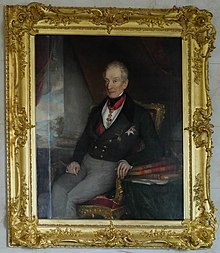Kynžvart Castle
Kynžvart Castle (German: Castle Königswart ) is located in the spa area of Okres Cheb (Eger) a few kilometers below the town of Bad Königswart .
history
At the end of the 16th century, the Franconian-Bohemian family of the von Zedtwitz had a renaissance fort built. After the Metternichs had acquired rule between 1623 and 1631 (year depending on the source), Count Philipp Emmerich had the dilapidated Renaissance fort converted into a baroque castle from 1681 to 1691 . Königswart Palace was given its current form in the style of Viennese classicism and empire style under Klemens Wenzel Lothar von Metternich , the Austrian state chancellor, who received it from his father on his birthday. He had it rebuilt from 1821 to 1836 by the Italian builder Pietro de Nobile . The castle has a 100 hectare English garden with an obelisk by Emperor Franz I (erected in 1835). Opposite the castle, the prince had farm buildings built for the meierhof and forester's house, which have been renovated to house a hotel and restaurant. The castle was confiscated from the Princely House in 1945.
In the castle itself there is a valuable library which contains medieval manuscripts and valuable prints, scientific books and encyclopedias from a number of scientific fields. The estate of the French poet Alexandre Dumas is kept here. In 1828 a museum was set up, in which scientific collections, coins, historical and technical curiosities, manuscripts, ancient Egyptian monuments, marble sculptures - etc. a. by Antonio Canova and objects of oriental art can be seen.
Karl Huss († 1838), the last executioner of Eger, acted as custodian . In the castle chapel there is a marble altar, which Pope Gregory XVI. Prince Metternich gave. In 1862 Prince Metternich received an ornamental plant from a diplomat and set it out in the park. Since then, this "ornamental plant", the Caucasian giant hogweed, has long since crossed national borders.
After extensive renovation work, the castle has been open to the public again since 2000. During the tour, the visitor is guided through 25 rooms. In 2008, the Council of Europe put Kynžvart Castle on the list of European cultural heritage.
literature
- Rudolf Hemmerle : Sudetenland: Signpost through a forgotten country . Bechtermünz Verlag, Augsburg 1996, p. 199, ISBN 3-86047-183-X
- Brochure Spa Hotel “Hubertus” Lázně Kynžvart
- "Free Press" from April 14, 2010, "Summer residence testifies to the splendor of bygone days" with remarks by the historian and castle director Miloš Riha
Web links
Individual evidence
- ↑ Huss, Karl on www.biographien.ac.at, accessed on June 6, 2018
- ↑ The giant hogweed on www.verwaltung.steiermark.at, accessed on June 6, 2018
- ↑ Klemens Wenzel von Metternich and Kynžvart at www.radio.cz, accessed on June 6, 2018
Coordinates: 50 ° 0 ′ 15.5 " N , 12 ° 36 ′ 20.1" E


